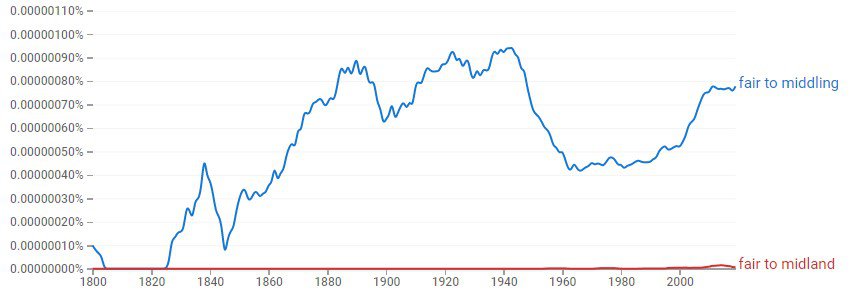So, you just moved to Texas, and you noticed many people saying the term fair to middling. What does it mean? And how does it differ from fair to Midland?
Continue reading to learn the difference between the two phrases. You’ll also learn about fair to middling’s origin, definition, and how to use it in sentences. Your English skills will surely go beyond fair to middling after reading this!
Is It Fair To Midland Or Fair To Middling?
The phrase fair to middling means something or someone is slightly above satisfactory or average, or “doing pretty well”. Fair to Midland is a mondegreen or misinterpretation of the original phrase.
What Does Fair To Midland Mean?
Imagine playing the novice-level version of Turkish March on piano but not the expert version. You can say that your piano skills are fair to middling. In the same way, you can express your knowledge in cooking is fair to middling if you’re still on the intermediate level.
The phrase fair to middlin’ without the g is a colloquial version written how it’s typically spoken in America. But fair to middling is a more formal and acceptable version.
Fair to Middling Origin
Fair to middling is a term, like the lesser of two evils, that dates back to the early 1800s. It initially referred to classifications of quality in farm goods. The quality of farm produce can be categorized as fine, good, fair, middling, and poor.
Poor was the term for the lowest quality produce, while fair and middle may indicate ordinary quality. The grade of quality was used to describe sheep, cotton, pins, and flour.
The word fair means top-of-the-line. Ittraces its roots from Latin phrases and Middle English words. Middling also has Middle English roots, which means medium in rank. It was used to refer to an intermediate grade of different commodities.
The phrase fair to middling developed into everyday speech by the 1860s, which means average or slightly above average. Referring to the historical rating scale, it was the rank between fair and middling.

In 1909, the United States Congress regulated the quality of cotton. Experts came up with new terms, including middling fair, strict good middling, good middling, strict middling, middling, and more.
In the USA, it is believed that fair to Midland was born separately from fair to middling with a different meaning. In the UK, fair to midland is a mishearing of fair to middling. But the history of this couplet of phrases requires more research.
Barry Popik, an American researcher, traced the first use of the mondegreen to May 1935. It was an NYT report that said, “Dr. William Tweddel… is what might be called a fair-to-Midland golfer.”
In 1968, Massachusetts used the term fair to midland without capitalizing the letter m or suggesting humor. It was their way of saying they have lost connection with Texas.
How To Use Fair To Middling In A Sentence
Use fair to middling the way you would use the words average or mediocre. These words are adjectives that modify a noun or a pronoun. Since fair to middling has more than one word, add a hyphen if you’re placing it before a noun.
However, you shouldn’t use the phrase in writings that require conciseness. Fair to middling is redundant because fair and middling have almost the same definitions, which is moderately good.
Some related words and phrases include acceptable, spotty, agreeable, adequate, half-decent, and your average bear.
Examples of Fair to Middling
Wheat and Oat harvest is well underway with Oats are well below last year’s average and wheat is fair to middling, mostly fair. (The Gainesville Register)
From the fair to middling dirt road, the white dunes could be seen rising above the red Kalahari sands long before pulling up at the entrance gate. (The Independent)
By any objective standard, President Trump’s speech to Congress Tuesday night was fair to middling: a standard-issue recitation of his priorities seasoned with calls for bipartisan compromise and closing with a lyrical appeal to members of Congress to join him in “dreaming big and bold and daring things for our country.” (The Los Angeles Times)
- Some parents are not satisfied with their kids’ fair-to-middling academic performance.
- Most middle-class families in the office had housing that is fair to middling.
- Your group’s work is fair to middling for a huge number of members.
- The sashimi from the new Japanese restaurant was fair to middling.
It’s Fair to Middling, Not Fair to Midland!
Now you know that the fair to middling origin was all about the intermediate qualities assigned to various kinds of goods. Later on, it became a figurative term that means slightly above average.
Do not use the phrase fair to Midland because it’s a mispronunciation of the phrase. Instead, say fair to middling or fair to middlin’.
